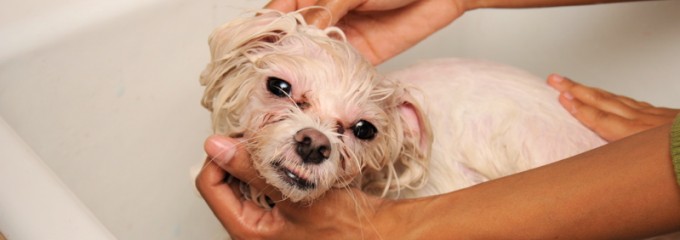Time for a Bath? The Sudsy Essentials for Your Pet

If you decide to forgo the groomer and attempt to wash your cat or dog at home, you’ll not only be saving money, you’ll likely be cutting down on your pet’s anxiety. Many critters get worked up the second they see their crate—they know something unusual is coming, and that can be enough to send them into a crying fit. Yes, bathing them in your own bathtub or sink will come with its challenges. But if you make sure that you have everything you need before you even turn on the faucet, you might be surprised by just how compliant your cat or dog can be:
- Patience. Long before you fill the tub, you should start preparing your pup or kitty for bath time. Many pets react more strongly to the unusual touch associated with grooming than the water itself. Spend some time petting and touching your cat or dog’s belly, paws, and toes the week or two before bathing.
- Nail clippers. The entire bathing process will go much smoother if you clip your pet’s nails beforehand. After you’ve gotten him or her used to your touch on the pads of his paws, scoop up your critter and gently push on the underside of his knuckles. That will make his claws come out and allow you to clip them quickly. Be careful, though; you shouldn’t cut above where the nail begins to curve (or you’ll risk hitting a vein).
- A brush. After you clip her nails, you’ll need to brush down your pet. This will get rid of any loose hair and dead skin. The good part about this step is that most cats and dogs actually enjoy it. Depending on whether your cat or dog has long or short hair, you should use a different brush (typically, a bristle or rubber brush for short hair and a slicker brush for long hair).
- A rubber mat. Make sure you put down a sturdy rubber mat in the bathtub so that your animal doesn’t slip while you suds him up. Only fill the tub with about three or four inches of lukewarm water.
- The proper shampoo—conditioner optional. You can’t use your own shampoo on your pet, as it could dry out his skin. Opt for a dog- or cat-friendly shampoo instead. If your pet has a long coat or fur that’s prone to knotting, you might also want to use conditioner.
- A wash cloth. After you’ve sudsed up your critter and rinsed him thoroughly, use a wash cloth and clean water to wipe his face, ears, and around his mouth.
- A big, fluffy towel. If you’re going to put a cat or dog through the trauma of getting squeaky clean, the least you can do is have a large, warm towel waiting for her at the end. Dogs might also like drying off via hair dryer—but this will depend on preference, so you should still have a towel on hand.
- Plenty of treats. When all else fails, bribe. If you give your pooch or kitty a treat right after he steps out of the tub, he’ll start to associate bath time with treat time. As a result, he might not be so hesitant to hop in the water next time.
Bathing Your Cat [ASPCA]
Bathing Your Dog [ASPCA]
Image: http://commons.wikimedia.org/wiki/File:Washing_a_dog_in_a_bath_tub.jpg
Attribution: CC BY 2.0/ Flickr/Andrew Vargas